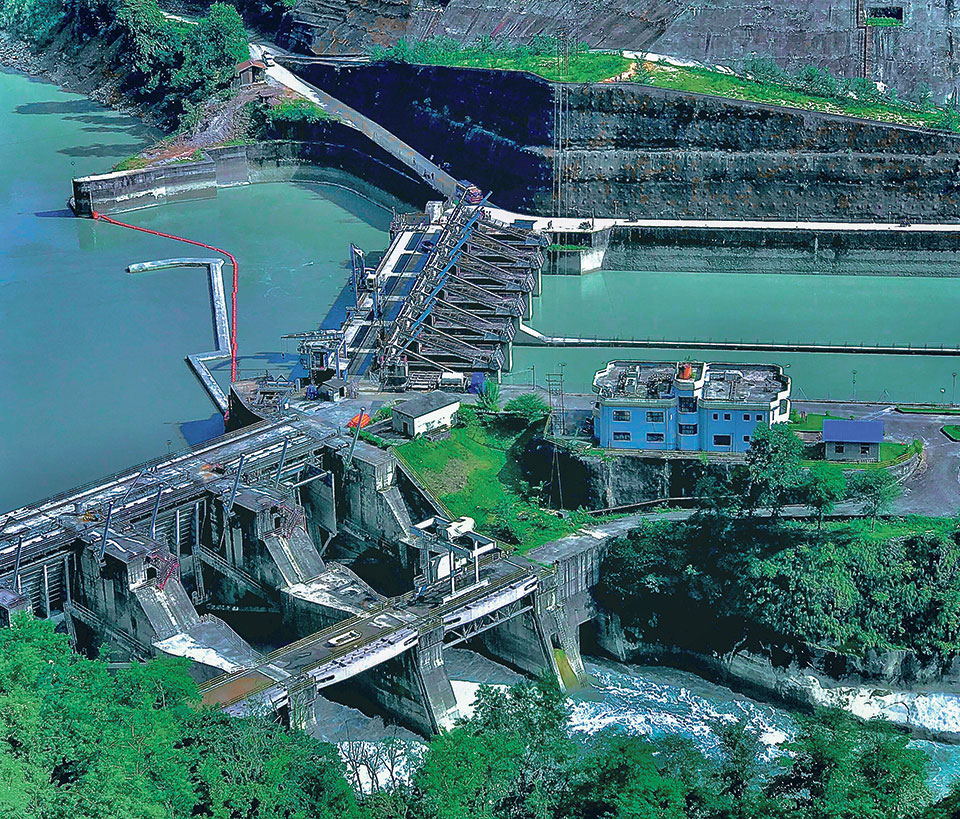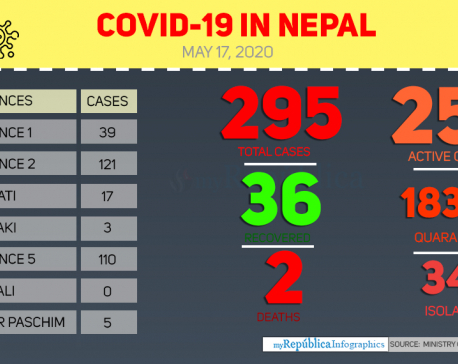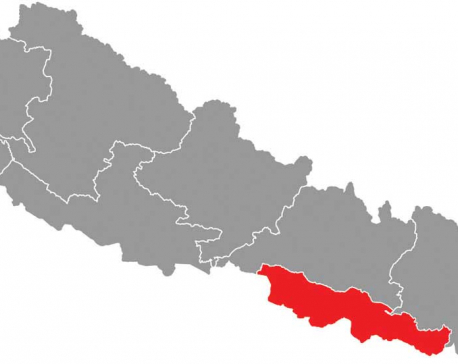
OR
How can we revive the energy sector post-COVID-19?
Published On: May 30, 2020 11:45 AM NPT By: Samrat KC


Samrat KC
KC is an energy consultant at Sustainable and Resilient Ideas Pvt. Ltd.14ksamrat@gmail.com
More from Author
Almost all sectors of Nepali economy have been interrupted, directly or indirectly, by the coronavirus crisis. Nepal’s energy sector also faces a tough challenge during this demanding time. The overall energy demand has dropped due to closure of transportation, industrial and service sectors. There has been as much as 70 % decline in the imports of petrol, diesel and aviation turbine fuels (ATF) fuels from India. There are no imports of kerosene and ATF, while that of LPG has decreased by around 34 % from last month. Nepal Electricity Authority (NEA) has also reported a decline of about 20-25 % in peak demand and around 30-35 % drop in energy demand in the period after lockdown. Under-construction hydropower plants of Independent Power Producers (IPP) also face a tough test ahead. The situation should improve once the economy revives, but uncertainty looms large in the absence of proper plan and policy.
Role of Nepal Oil Corporation (NOC)
The role of NOC in reviving the country’s economy can be elementary. Last year, NOC’s contribution to the GDP was around 13-14 % of the total Rs. 3.5 trillion. Its imports also contributed to 11-13 % in the total trade deficit of Rs. 1.2 trillion. Last year, NOC paid Rs. 177 billion to the Indian Oil Corporation. The decline in oil imports have helped reduce the trade deficit by Rs. 8.5 billion in the month of March and Rs 4.7 billion in April, when calculated based on the reduced price of the petroleum products.
The government has been losing Rs. 180 million daily in customs revenue in the first 24 days of the lockdown due to the reduced activity of NOC. Compared to the daily collection of Rs. 240 million last year in the month of April, this year’s collection was only Rs. 60 million daily. Also, the NOC paid Rs. 2.2 billion in dividends and Rs. 3 billion in income tax to the government last year but if the current situation does not change, it will only be able to provide half that amount this year.
The NOC has also forecasted that for the next six months, the price of petroleum products will decline, on average, by Rs. 22. If the reduction in import price is not reflected in the selling price, the profit earned from this will be Rs. 5.5 billion a month.
The government has recently increased the infrastructure development tax on sales of ATF, petrol and diesel from Rs. 5 to Rs. 10 per liter. Another approach to generating new revenue could be to reduce the border price difference. Currently, on average the price difference between India and Nepal is Rs. 25 per liter. As India levies tax both at the state and the federal level, diesel and petrol are cheaper in Nepal. Cheaper oil prices in Nepal relative to India have been a subject of huge headache to the NOC for a long time. If this is adjusted and the price between the two countries are kept similar, additional Rs. 6 billion can be generated in revenue.
As per the budget for the fiscal year 2020/2021, the import tax on the diesel, petrol and kerosene has been increased by Rs.10 per liter. The tax for ATF and LPG has been kept the same. With this desperate move to improve revenue collection, the government plans to collect Rs. 25 billion per month in revenues. The government has also decided to remove the infrastructure tax of Rs.10 per liter on ATF to ease the burden of the pandemic on the country’s aviation industry.
However, this crisis also provides the government an opportunity to envision a different future, one that is not heavily reliant on other countries for its energy needs. In particular, the government should seize the opportunity to start promoting local energy resources, decrease dependency on imported fossil fuels sources and nudge them toward using more local, cleaner sources.
Electricity sector: NEA’s precarious situation
In this crisis, the government-owned utility faces grave financial risks. Due to reduced economic activity in the country, electricity demand is almost two-thirds of what it used to be. Due to the lockdown restrictions, the NEA has been unable to collect bills from 4-4.5 million of its household consumers, who account for 42% of total electricity sales. Except for the electronic receipts from its large industrial customers of around Rs. 5-6 million, even which is only 3% of its usual receipts, NEA’s cash flow has essentially dried up. Adding to its financial worry is the monthly payment of more than Rs. 2 billion to the IPPs which it has been making through its reserves, which will soon run dry up
The import of electricity from India has also reduced to just 100 MW only during the peak hours. The average demand for a day is 650 MW and average generation is around 700 MW while the nighttime peak demand is just around 450 MW. This has caused electricity to be wasted, resulting in loss for NEA. Since all the IPP’s hydropower are of run-of-river type, the matching of demand and supply are done within NEA’s power plants. This adversity has also made the authority realize the importance of peaking power plants, storage type power plants to optimize the power management. The financial burden on NEA is ever mounting as their other sources of income like earnings from interests from their reserve funds have also been affected. Moreover, NEA is also morally bound to provide additional incentive to its employees who are working during this crisis. Devaluation of NPR will also play a huge role in NEA’s finances as some projects are paid in foreign currency.
The recently announced 2020/2021 fiscal budget has attempted to ease the burden on the domestic users as well as the commercial and industrial users by reducing the tariff. The domestic user will get as much as 25% discount if they consume 150 units or less and 15 % if they consume 250 units or less. It has also made it tariff-free for those consumers who consume 10 units or less electricity. For the industrial consumers, the demand charge during the period of lockdown has been waived and a 50% discount on tariff will be provided during the off-peak time. Electricity use in irrigations, drinking water, electric transportation and household cooking are also encouraged with subsidy. These decisions are a positive move as there will be an increase in demand for electricity.
The 2020/2021 fiscal budget has increased the taxes on the electric vehicles (EV). Previously, there was only 13 % VAT and minimal custom tax levied on EVs. Now, there will be as much as 40-60 % excise duty, up to 60% custom tax and 13 % VAT depending on the EVs specifications. This unpopular decision is seen as a discouraging factor for promotion of electric transportation and reducing their competitiveness. Since the government has imported fewer fossil fuels in the last two months, they should have realized the savings they can generate among its other advantages.
NEA has been encouraging domestic consumers to use more electricity, especially in cooking. Fuel-switching, particularly from LPG and firewood for cooking to electricity can have a long-term positive impact. A recent study at the Center for Energy Studies, IOE claimed that cooking in induction cooktops can be as much as 40 % cheaper and quicker, requiring 32% less time. A major challenge in the promotion of electric cooking is the reliability of the distribution system, switching behavior and investment of electric cooking technology by a household. Currently, NEA is operating at its optimum supply capacity during peak hours between 6 PM and 11 PM, which also includes a typical household’s cooking time. The added load of household electric cooking can be a burden on the peak load supply for NEA. One solution can be by changing the way large industrial and commercial consumers use electricity. To facilitate households for electric cooking during peak hours, NEA can introduce a Time of Day (TOD) tariff system where the industrial and commercial consumers will be charged more during peak hours, reducing their consumption. This can be a temporary solution until the country can have a surplus electricity supply.
Under-construction projects at risk
There are around 3000 MWs of hydro power plants under construction. Most have been halted, increasing costs and completion time. Without any support from the government, interest rates alone would amount to around Rs. 130 million per day. Even projects that are near completion are expected to be significantly delayed due to equipment and labor shortages. Construction of hydropower plants during the monsoon season is not favorable. The outbreak happened during the dry season and when the lockdown likely eases, monsoon will further disrupt progress of the projects. Few under-construction projects like the Upper Tamakoshi hydropower are operating, albeit at a reduced capacity.
Other implications
The targets set by the government to increase the total consumption of electricity to 10,000 MWs and the total export to 5,000 MWs by 2030 will likely be affected by this pandemic. To reach that figure, consumption should increase at a pace of 25% yearly, but even before the pandemic it was only around 18-19 %. The government has also envisioned full electrification of the country which will be assisted by 1300 MWs of electricity and 200 new solar mini grids that are expected to be added to the national grid in the next fiscal year. Presently, around 90% of the country is electrified through national grid and off-grid electricity. The per capita consumption of 220 kwh is also planned to increase to 1,500 kWh by the next decade. While the government was on the right track to achieving this goal, things have now become uncertain, and without a change in strategy the goal is in danger of becoming a pipe-dream.
Conclusion
Energy sector has always been in crisis in Nepal. It was not until recently that we have had any hope of overcoming it from the under-construction hydropower projects. But the pandemic might further deepen the risk faced by the energy sector. While it is still difficult to predict the consequences of the pandemic, however some are evident. The NOC has a huge role to play to support the government in fighting against the negative impact of the COVID-19. The NEA faces a cash crunch due to non-payment of utility and might face difficulty in paying the IPPs. The generated power is also under-utilized causing financial loss. The survival of under construction projects are also at risk with delays in implementation and increase in costs. The government has a huge responsibility to ensure that the impacts of COVID-19 will be minimal in the energy sector and that the risks are shared.
KC is an energy consultant at Sustainable and Resilient Ideas Pvt. Ltd.
Email: 14ksamrat@gmail.co
You May Like This

Health ministry confirms three new COVID-19 cases, number of total cases reaches 295
KATHMANDU, May 17: Nepal reported three new cases of COVID-19 on Sunday evening, taking the national tally to 295. ... Read More...

Two new COVID-19 cases confirmed today, total number jumps to 51
KATHMANDU, April 26: The Ministry of Health and Population has confirmed two more COVID-19 cases on Sunday. ... Read More...

Province 2 govt to provide Rs 5 million in relief to victim families of those losing lives in fight against COVID-19
JANAKPUR, April 10: Province 2 government has decided to provide relief amount of Rs 5 million to the victim families of... Read More...



Just In
- World Malaria Day: Foreign returnees more susceptible to the vector-borne disease
- MoEST seeks EC’s help in identifying teachers linked to political parties
- 70 community and national forests affected by fire in Parbat till Wednesday
- NEPSE loses 3.24 points, while daily turnover inclines to Rs 2.36 billion
- Pak Embassy awards scholarships to 180 Nepali students
- President Paudel approves mobilization of army personnel for by-elections security
- Bhajang and Ilam by-elections: 69 polling stations classified as ‘highly sensitive’
- Karnali CM Kandel secures vote of confidence















Leave A Comment